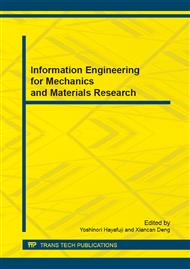[1]
Gao Jingfeng, Peng Yongzhen, Wang Shuying. Application of Artificial Neural Network and Expert System in Biological Sewage Treatment System: Environmental Pollution & Control, Vol. 26, 1 (2004), pp.31-33.
Google Scholar
[2]
Ruey-Fang Yu. Feed-forward Dose Control of Wastewater Chlorination Using On-line PH and ORP Titration: Chemosphere, 56 (2004), pp.973-980.
DOI: 10.1016/j.chemosphere.2004.03.015
Google Scholar
[3]
Martin Cote, P. A. Bernard, Grandjean. Dynamic Modeling of the Activated Sludge Process: Improving Predation Using Neural Networks: Water Research, Vol. 29, 4 (1995), pp.995-1004.
DOI: 10.1016/0043-1354(95)93250-w
Google Scholar
[4]
Dae Sung Lee, Jong Moon Park. Neural Network Modeling for On-line Estimation of Nutrient Dynamics in a Sequentially-operated Batch Reactor: Bio Technology, 75 (1999), pp.229-239.
DOI: 10.1016/s0168-1656(99)00171-6
Google Scholar
[5]
Dong-Jin Choi, Heek Yung Park. A Hybrid Artificial Neural Network as a Software Sensor for Optimal Control of a Wastewater Treatment Process: Water Research, Vol. 35, 16 (2001), pp.3959-3967.
DOI: 10.1016/s0043-1354(01)00134-8
Google Scholar
[6]
U. Meyer, H. J. Popel. Fuzzy Control for Nitrogen Removal and Energy Saving in Wwt-plants with Pre-denitrification: W at Sci & Tech, Vol. 47, 11 (2003), pp.69-76.
DOI: 10.2166/wst.2003.0588
Google Scholar
[7]
A. Traore, S. Grieu, S. Puig, L. Corominas, F. Thiery, M. Polit, J. Colprim. Fuzzy Control of Dissolved Oxygen in a Sequencing Batch Reactor Pilot Plant: Chemical Engineering Journal, 111 (2005), pp.13-19.
DOI: 10.1016/j.cej.2005.05.004
Google Scholar
[8]
E. Murnleitner, T. Matthias, A. Delgado. State Detection and Control of Overloads in the Anaerobic Wastewater Treatment Using Fuzzy Logic: Water Research, Vol. 36, 1 (2002), pp.201-211.
DOI: 10.1016/s0043-1354(01)00186-5
Google Scholar
[9]
S. A. Manesis. Intelligent Control of Wastewater Treatment Plants: Artificial Intelligent in Engineering, 12 (1998), pp.275-281.
DOI: 10.1016/s0954-1810(97)10002-4
Google Scholar
[10]
Gao Jingfeng, Peng Yongzhen, Wang Shuying. The Construction of Fuzzy Controller of Denitrification in SBR Process and the Choice of Carbon Addition Method: Acta Scientiae Circumstantiae, Vol. 23, 6 (2003), pp.733-737.
Google Scholar
[11]
J. Riesco, J. Calvo, J. M. Martin-Sanchez. Adaptive Predictive Expert (ADEX) Control: Application to Wastewater Treatment Plants: IEEE Conference on Control Applications Proceedings, Glasgow, United Kingdom, (2002).
DOI: 10.1109/cca.2002.1038739
Google Scholar
[12]
J. Flores, B. Arcay, J. Arias. An Intelligent System for Distributed Control of an Anaerobic Wastewater Treatment Process: Engineering Applications of Artificial Intelligence, Vol. 13, 4 (2000), pp.485-494.
DOI: 10.1016/s0952-1976(00)00015-4
Google Scholar
[13]
J. Comas, et al. A Knowledge-based Approach to the Deflocculation problem: Integrating On-line, Off-line, and Heuristic Information: Water Research, 37 (2003), pp.2377-2387.
DOI: 10.1016/s0043-1354(03)00018-6
Google Scholar
[14]
A. Punal, et al. An Expert System for Monitoring and Diagnosis of Anaerobic: Water Research, 36 (2002), pp.2656-2666.
Google Scholar
[15]
Yoon-Seok Hong, et al. Evolutionary Self-organising Modeling of a Municipal Wastewater Treatment Plant: Water Research, 37 (2003), pp.1199-1212.
DOI: 10.1016/s0043-1354(02)00493-1
Google Scholar
[16]
S. Yagi, S. Shiba. Application of Genetic Algorithms and Fuzzy Control to Combined Sewer Pumping Station: Wat. Sci. Tech, Vol. 39, 9 (1999), pp.217-224.
DOI: 10.2166/wst.1999.0481
Google Scholar
[17]
W. C. Chen. Rough Set-based Hybrid Fuzzy-neural Controller Design for Industrial Wastewater Treatment: Water Research, 37 (2003), pp.95-107.
DOI: 10.1016/s0043-1354(02)00255-5
Google Scholar


